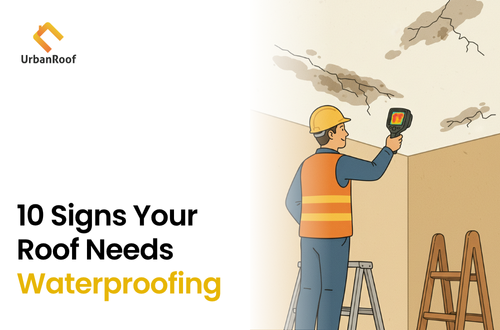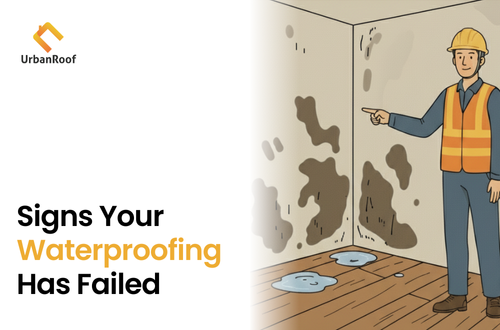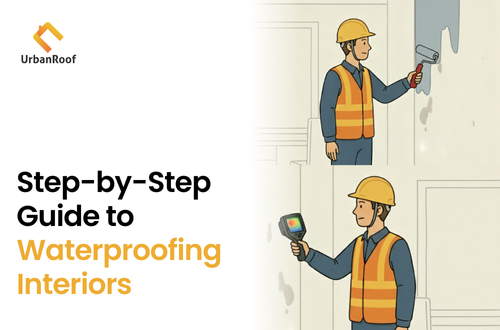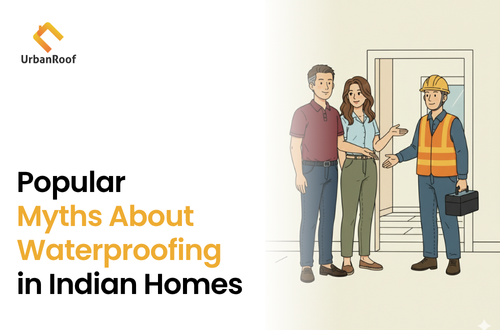10 Signs Your Roof Needs Waterproofing
Your roof works tirelessly to shield your home from India’s intense sun, rain, and humidity. Over time, constant exposure can weaken its waterproofing layer, reducing its ability to protect your interiors. Many homeowners realize the issue only when water starts dripping from the ceiling — by then, repairs become costly. The good news? Your Roof Needs Waterproofing only after giving several early warning signs. Recognizing them on time helps you take preventive action before damage spreads.
This guide by UrbanRoof explains the 10 most common signs your Roof Needs Waterproofing, how to identify them, and what actions you should take before the next monsoon season.
Why Paying Attention to Roof Waterproofing Signs Matters
Roof waterproofing isn’t just about preventing leaks — it’s about protecting your home’s structure, walls, and interiors from moisture damage. Once water seeps in, it weakens concrete, causes paint to peel, and promotes mould growth. When you know the signs your Roof Needs Waterproofing, you can act early to:
- Avoid expensive repairs later
- Protect walls, paint, and ceilings from seepage
- Extend the life of your roof by several years
Let’s explore the key warning signs in detail and understand what they mean for your home.
1. Water Stains or Discolouration on Ceilings and Walls
It often starts small — a faint yellow patch on your ceiling or wall. If that patch spreads after every rain, it’s a clear sign your Roof Needs Waterproofing. This happens when rainwater seeps through cracks in the roof slab and stains the ceiling plaster.
What to do: Lightly touch or press the affected area. If it feels damp or soft, moisture is actively seeping through. Call for a professional roof inspection immediately — not after visible leaks appear.
2. Damp or Musty Smell Indoors
A musty smell, especially in upper rooms or attics, often means water is trapped between roof layers or inside walls. Even if you can’t see dampness yet, this odour signals mould and bacterial growth — a major reason why your Roof Needs Waterproofing.
Tip: Pay attention to persistent damp smells near staircases, top-floor rooms, or ceiling corners. It usually points to hidden seepage.
3. Peeling Paint or Bubbling Plaster Near Roof Edges
Peeling paint, bubbling plaster, or powdery white salt deposits (efflorescence) are surface indicators that your Roof Needs Waterproofing. These usually start near ceiling edges and spread downward as moisture travels through the roof surface into the wall plaster.
Why it matters: Ignoring this early sign allows water to reach deeper structural layers, leading to higher repair costs later.
4. Water Pooling or Uneven Surface on the Roof
After rainfall, your terrace should dry within a few hours. If water stands for more than a day, your roof slope or drainage is compromised — a strong indicator that your Roof Needs Waterproofing. Standing water weakens both concrete and the protective coating below.
Check this: After rainfall, inspect the terrace. If puddles remain after 24 hours, it’s time to correct the slope or redo the waterproofing layer.
5. Cracks or Splits on the Roof Surface
Cracks — whether hairline or wide — are among the most common signs your Roof Needs Waterproofing. Due to India’s extreme temperature variations, roofs expand in summer and contract in winter, creating cracks that let water seep through.
Pro tip: Pour a little water on the cracked area. If it absorbs quickly, the surface is compromised and needs immediate waterproofing attention.
6. Damaged Flashing or Gaps Around Roof Joints
Flashing refers to the edges and joints around pipes, vents, and parapet walls. When these areas develop cracks or rust, water enters easily — another sure sign your Roof Needs Waterproofing.
What to do: Reseal minor gaps immediately and have a professional inspect these joints before every monsoon.
7. Moss or Algae Growth on the Roof
Green moss or algae patches may look harmless but they trap moisture, keeping the surface damp for long periods. This continuous wetness signals that your Roof Needs Waterproofing.
Tip: Clean moss regularly and check for cracks or discolouration underneath. If the surface remains damp, reapply waterproofing.
8. Sagging or Soft Roof Sections
A sagging or spongy feel when walking on your terrace is a red flag. It means water has penetrated deep into the roof slab and weakened the structure — a critical sign your Roof Needs Waterproofing.
Why it matters: Sagging roofs are unsafe. Schedule a professional inspection immediately if you notice any unevenness or soft spots.
9. Increased Indoor Humidity or Temperature Fluctuations
When your waterproofing fails, your top-floor rooms become more humid or hotter than usual. This happens because moisture and heat pass easily through the damaged roof. It’s another subtle indicator that your Roof Needs Waterproofing.
Check: Compare your top floor with lower floors. Noticeable humidity or temperature differences mean the roof’s insulation has been compromised.
10. Rusting Around Screws or Metal Roof Components
For homes with metal roofs or concrete terraces with railings, rust stains around joints or anchors are visible signs your Roof Needs Waterproofing. Corrosion weakens both metal fittings and concrete strength over time.
Action: Clean visible rust, reseal joints, and apply an anti-corrosive coating after waterproofing repairs.
What to Do When You Spot These Signs
Not every symptom means you need a full waterproofing redo, but each deserves attention. The sooner you act, the more you save on costly repairs. Here’s what you can do if your Roof Needs Waterproofing:
- Inspect your terrace after rainfall for cracks or water pooling
- Note or photograph any stains, damp areas, or peeling paint
- Consult a waterproofing expert for moisture or flood testing
- Fix minor cracks and reseal joints immediately
- Schedule preventive re-waterproofing every 3–5 years
Remember: Waterproofing is not a one-time job — it’s an ongoing protection plan for your home.
How to Maintain a Healthy Roof Year-Round
- Clean roof drains and outlets before and after monsoon
- Reapply protective coatings every few years
- Remove leaves, debris, and moss regularly
- Trim overhanging branches that cause shade and moisture build-up
- Use high-quality waterproofing membranes suitable for Indian conditions
Your roof doesn’t fail overnight — it gives warning signs well in advance. Peeling paint, water stains, moss growth, or cracks all mean your Roof Needs Waterproofing. If you notice even two or three of these signs, don’t wait for leaks to appear. Get a professional inspection before monsoon to save thousands in repair costs and keep your home strong for years.
Final Thoughts
Understanding when your Roof Needs Waterproofing is key to preventing costly structural damage. Regular inspection, timely maintenance, and professional waterproofing solutions can keep your home safe and durable for decades.
UrbanRoof specializes in advanced roof diagnostics, waterproofing systems, and long-term protection plans designed for Indian weather. Our experts identify problem areas early and deliver solutions that extend your roof’s lifespan.
Book a Professional Roof Waterproofing Inspection Today
Don’t wait for visible leaks. Book your Roof Needs Waterproofing inspection with UrbanRoof today. Get engineer-led reports, thermal imaging, and custom waterproofing plans that protect your home before the next monsoon hits.
Frequently Asked Questions
Everything you need to know about thermal scanning and our reports
How often should I waterproof my roof in India?
Most experts recommend re-waterproofing every 3 to 5 years, depending on material and exposure. In coastal or high-rainfall areas, inspect more frequently.
Can I do roof waterproofing myself?
Minor cracks can be sealed with DIY kits, but professional waterproofing ensures proper surface prep and coating thickness for long-lasting results.
What is the best time to waterproof a roof in India?
How can I tell if existing waterproofing is failing?
Look for damp patches, ceiling stains, terrace cracks, or moss growth. A simple water ponding test also reveals leaks.
Does waterproofing reduce heat inside the house?
Yes, modern waterproof coatings also reflect heat, keeping upper rooms cooler during summer months.




